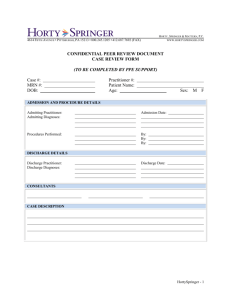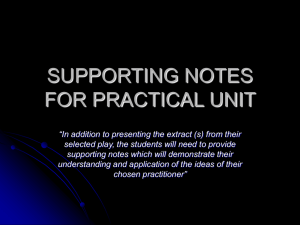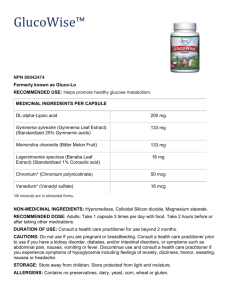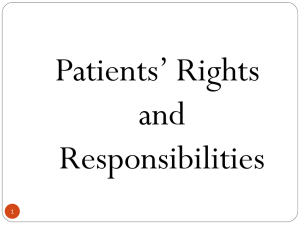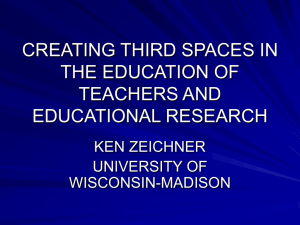Rhetoric on the Paper Level Beginner Developing Practitioner
advertisement
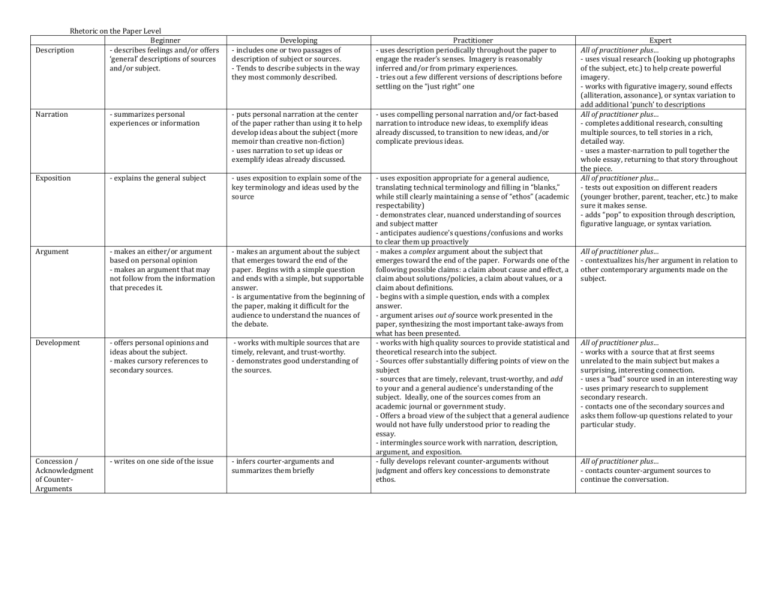
Rhetoric on the Paper Level Beginner Description - describes feelings and/or offers ‘general’ descriptions of sources and/or subject. Developing - includes one or two passages of description of subject or sources. - Tends to describe subjects in the way they most commonly described. Practitioner - uses description periodically throughout the paper to engage the reader’s senses. Imagery is reasonably inferred and/or from primary experiences. - tries out a few different versions of descriptions before settling on the “just right” one Narration - summarizes personal experiences or information - puts personal narration at the center of the paper rather than using it to help develop ideas about the subject (more memoir than creative non-fiction) - uses narration to set up ideas or exemplify ideas already discussed. - uses compelling personal narration and/or fact-based narration to introduce new ideas, to exemplify ideas already discussed, to transition to new ideas, and/or complicate previous ideas. Exposition - explains the general subject - uses exposition to explain some of the key terminology and ideas used by the source Argument - makes an either/or argument based on personal opinion - makes an argument that may not follow from the information that precedes it. - makes an argument about the subject that emerges toward the end of the paper. Begins with a simple question and ends with a simple, but supportable answer. - is argumentative from the beginning of the paper, making it difficult for the audience to understand the nuances of the debate. Development - offers personal opinions and ideas about the subject. - makes cursory references to secondary sources. - works with multiple sources that are timely, relevant, and trust-worthy. - demonstrates good understanding of the sources. Concession / Acknowledgment of CounterArguments - writes on one side of the issue - infers courter-arguments and summarizes them briefly - uses exposition appropriate for a general audience, translating technical terminology and filling in “blanks,” while still clearly maintaining a sense of “ethos” (academic respectability) - demonstrates clear, nuanced understanding of sources and subject matter - anticipates audience’s questions/confusions and works to clear them up proactively - makes a complex argument about the subject that emerges toward the end of the paper. Forwards one of the following possible claims: a claim about cause and effect, a claim about solutions/policies, a claim about values, or a claim about definitions. - begins with a simple question, ends with a complex answer. - argument arises out of source work presented in the paper, synthesizing the most important take-aways from what has been presented. - works with high quality sources to provide statistical and theoretical research into the subject. - Sources offer substantially differing points of view on the subject - sources that are timely, relevant, trust-worthy, and add to your and a general audience’s understanding of the subject. Ideally, one of the sources comes from an academic journal or government study. - Offers a broad view of the subject that a general audience would not have fully understood prior to reading the essay. - intermingles source work with narration, description, argument, and exposition. - fully develops relevant counter-arguments without judgment and offers key concessions to demonstrate ethos. Expert All of practitioner plus… - uses visual research (looking up photographs of the subject, etc.) to help create powerful imagery. - works with figurative imagery, sound effects (alliteration, assonance), or syntax variation to add additional ‘punch’ to descriptions All of practitioner plus… - completes additional research, consulting multiple sources, to tell stories in a rich, detailed way. - uses a master-narration to pull together the whole essay, returning to that story throughout the piece. All of practitioner plus… - tests out exposition on different readers (younger brother, parent, teacher, etc.) to make sure it makes sense. - adds “pop” to exposition through description, figurative language, or syntax variation. All of practitioner plus… - contextualizes his/her argument in relation to other contemporary arguments made on the subject. All of practitioner plus… - works with a source that at first seems unrelated to the main subject but makes a surprising, interesting connection. - uses a “bad” source used in an interesting way - uses primary research to supplement secondary research. - contacts one of the secondary sources and asks them follow-up questions related to your particular study. All of practitioner plus… - contacts counter-argument sources to continue the conversation. Rhetoric, on the sentence level Beginner Syntax (sentence - uses appositives for background structure) information Developing - uses appositives after the noun - uses other non-restrictive phrases or clauses - uses participle phrases - may struggle with figuring out what information belongs in the “background” vs. the “foreground” - a few comma errors Artistic Restatement - restates key ideas more than once. - restates important ideas more than once to draw attention to their importance – experiments with alliteration, assonance, parallelism, or figurative language. 1 – 2 Sentence Variation Punch creates a long sentence followed by a short sentence with some mechanical inconsistencies in the first sentence. - uses a long sentence followed by a short sentence for variation. Transitions - uses SLIDER transition words - uses SLIDER words/phrases - makes some connections between sources Practitioner - uses appositives for background information. Uses appositives both before and after the noun. - uses other non-restrictive phrases for background information/exposition. Uses non-restrictive phrases both before and after the noun. - uses participle phrases, both past and present, without any dangling modifiers. Uses participle phrases both before and after the noun. - uses non-restrictive clauses for background information/exposition - uses non-restrictive “which” and restrictive “that” to correctly to modify nouns - uses commas to consistently and correctly indicate nonrestrictive and restrictive elements - draws readers attention to important ideas by restating them twice, with the second statement including at least one of the following: assonance, alliteration, simple parallelism, figurative language (metaphor, simile, hyperbole, synecdoche, etc.). - The rhetorical technique makes the paraphrased idea clearer as well as making it stand out. - at a key moment in the paper, uses a long sentence followed by a short, simple sentence. Creates powerful emphasis of a position or idea. - the second sentence is short but packed with meaning - first sentence sets up the punch-line of the second sentence. - each source/subject is connected to the one that precedes it - uses a range of S.L.I.D.E.R. words/phrases. - uses recursive transitions to begin a number of paragraphs. - guides the reader carefully through the paper, always keeping the central topic clearly at the forefront. Expert All of practitioner, plus… * uses the cumulative and periodic sentence for effect. * experiments with at least one sentence that includes at least five phrasal interrupters but is still mechanically sound. All of practitioner plus… * the wow factor. Some of the restatements are original and end up complicating the original idea. All of practitioner plus… * the wow factor. The syntax is used to mirror an idea being worked with in the sentences. All of practitioner plus… - uses anchor words to create transitions - uses at least one jump cut - uses of parallel construction to hint at connections. - uses “extent” transitions Source Work Source Set-up Beginner - mentions source’s name Developing - sets up some background about sources, often in a separate sentence Practitioner - sets up sources’ ethos (or lack thereof) - employs different syntaxes to introduce source - sets up a source within a source with information about both Source Paraphrasing - offers a general opinion about the source’s perceived ideas. - summarizes key ideas from the source’s article in a way that will be clear to a general audience. - quotes directly from the source. Source exemplification, expansion, examination, or experimentation (The Four E’s) - explains the sources’ main ideas. - experiments with the four e’s in his/her writing, with the result being that sometimes the general audience will understand the topic more clearly. - reads deeply into the source (doesn’t just work with the abstract or first page) - summarizes clearly source’s major ideas/arguments - paraphrases and points out important nuances - in addition to paraphrasing quotes directly from the source where the language is particularly potent and/or interesting. Takes the “just right amount” from sources when quoting. - demonstrates an in-depth knowledge of the source and makes the source’s ideas/arguments understandable for a general audience. - creates “revealing” examples that explain a source’s argument/idea. - chooses examples that will speak to the “general audience” the paper is written for - expand on the source’s argument/idea by connecting it to other sources/ideas/information or applying it to circumstances not originally looked at by the source. - examines some of the unspoken assumptions being made by the source, limitations to the source, the impact of the source’s context, or the specific language used by the source. - experiments with the source’s ideas by conducting your own informal research based on what you have read and connecting what you found back to the source. - uses a range of the four e’s where appropriate to fully develop the sources. Considers carefully how and when to employ each of the e’s. Expert All of practitioner plus… * points out interesting connections between sources * uses description to bring the source to life * scatters background throughout the paraphrase, considering careful when and how to offer background information and for what purpose * considers the relevance of some of the background to understanding the source’s arguments All of the practitioner plus… * works on the most difficult parts of an academic source with friend or teacher. * contacts source to ask follow-up questions about ideas that are unclear or need further elucidation. All of the practitioner plus… * develops a single source over multiple paragraphs that build in intrigue.

